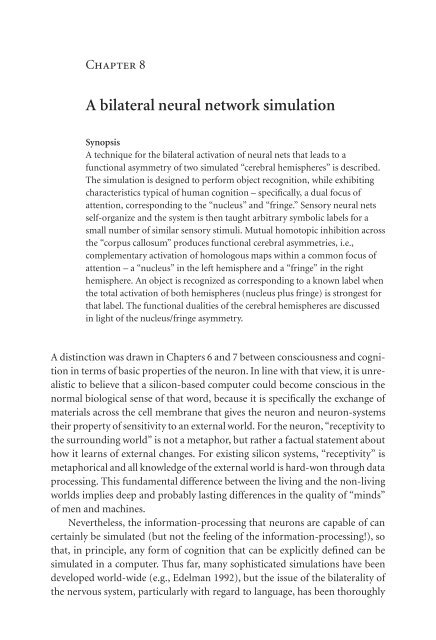Tone of Voice and Mind : The Connections between Intonation ...
Tone of Voice and Mind : The Connections between Intonation ...
Tone of Voice and Mind : The Connections between Intonation ...
You also want an ePaper? Increase the reach of your titles
YUMPU automatically turns print PDFs into web optimized ePapers that Google loves.
Chapter 8<br />
A bilateral neural network simulation<br />
Synopsis<br />
A technique for the bilateral activation <strong>of</strong> neural nets that leads to a<br />
functional asymmetry <strong>of</strong> two simulated “cerebral hemispheres” is described.<br />
<strong>The</strong> simulation is designed to perform object recognition, while exhibiting<br />
characteristics typical <strong>of</strong> human cognition – specifically, a dual focus <strong>of</strong><br />
attention, corresponding to the “nucleus” <strong>and</strong> “fringe.” Sensory neural nets<br />
self-organize <strong>and</strong> the system is then taught arbitrary symbolic labels for a<br />
small number <strong>of</strong> similar sensory stimuli. Mutual homotopic inhibition across<br />
the “corpus callosum” produces functional cerebral asymmetries, i.e.,<br />
complementary activation <strong>of</strong> homologous maps within a common focus <strong>of</strong><br />
attention – a “nucleus” in the left hemisphere <strong>and</strong> a “fringe” in the right<br />
hemisphere. An object is recognized as corresponding to a known label when<br />
the total activation <strong>of</strong> both hemispheres (nucleus plus fringe) is strongest for<br />
that label. <strong>The</strong> functional dualities <strong>of</strong> the cerebral hemispheres are discussed<br />
in light <strong>of</strong> the nucleus/fringe asymmetry.<br />
A distinction was drawn in Chapters 6 <strong>and</strong> 7 <strong>between</strong> consciousness <strong>and</strong> cognition<br />
in terms <strong>of</strong> basic properties <strong>of</strong> the neuron. In line with that view, it is unrealistic<br />
to believe that a silicon-based computer could become conscious in the<br />
normal biological sense <strong>of</strong> that word, because it is specificallytheexchange<strong>of</strong><br />
materials across the cell membrane that gives the neuron <strong>and</strong> neuron-systems<br />
their property <strong>of</strong> sensitivity to an external world. For the neuron, “receptivity to<br />
the surrounding world” is not a metaphor, but rather a factual statement about<br />
how it learns <strong>of</strong> external changes. For existing silicon systems, “receptivity” is<br />
metaphorical <strong>and</strong> all knowledge <strong>of</strong> the external world is hard-won through data<br />
processing. This fundamental difference <strong>between</strong> the living <strong>and</strong> the non-living<br />
worlds implies deep <strong>and</strong> probably lasting differences in the quality <strong>of</strong> “minds”<br />
<strong>of</strong> men <strong>and</strong> machines.<br />
Nevertheless, the information-processing that neurons are capable <strong>of</strong> can<br />
certainly be simulated (but not the feeling <strong>of</strong> the information-processing!), so<br />
that, in principle, any form <strong>of</strong> cognition that can be explicitly defined can be<br />
simulated in a computer. Thus far, many sophisticated simulations have been<br />
developed world-wide (e.g., Edelman 1992), but the issue <strong>of</strong> the bilaterality <strong>of</strong><br />
the nervous system, particularly with regard to language, has been thoroughly


